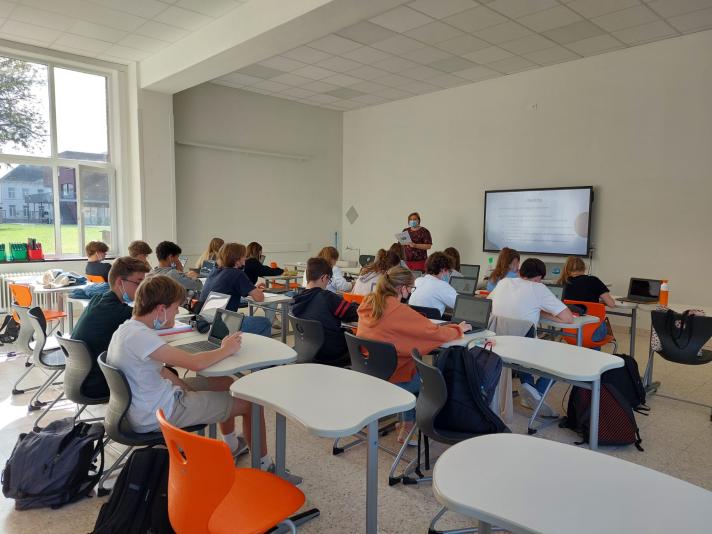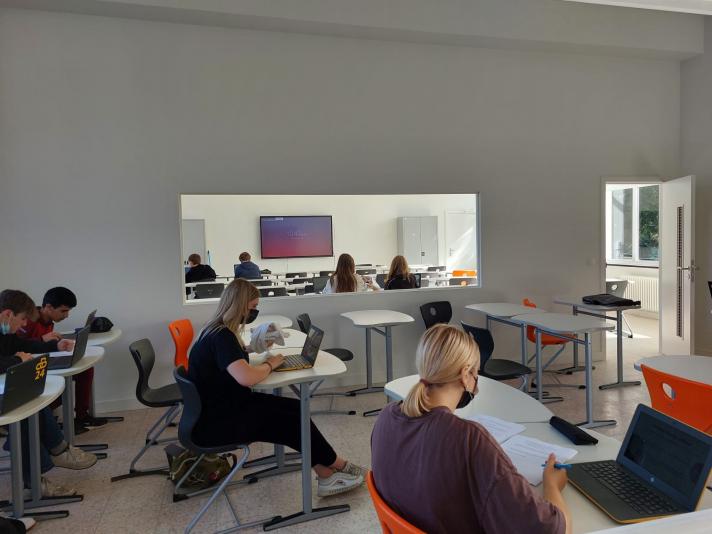Topic(s) addressed
The project’s primary objective was to optimise the use of a Future Classroom Lab (FCL) for as many teachers and pupils as possible through the process of staff development, with its primary topics being ICT, new technologies, digital competences, and new innovative curricula, educational methods, and the development of training courses. The project’s focus, “KTA Brakel verruimt zicht op de toekomst met het Future Classroom Lab” (KTA Brakel Broadens its View of the Future with the Future Classroom Lab) was perfectly aligned with the school’s new policy vision of moving towards the development of a renewed pedagogical-didactic approach. A dimension of the project was tied to the need to address new ideas and insights towards overcoming limitations in traditional face-to-face education approaches, with job-shadowing exercises that had been carried out in both Finland and Denmark providing indications as to the ways in which ICT use encourages, develops, and strengthens blended learning. Schools that were visited in Finland and Denmark strongly emphasised independent working and self-regulated learning, with participants having noted that independent work at school would necessitate the need for considerably different efforts and strategies on the part of students, as opposed to the predominantly frontal teaching methods that were being practised at the time at the school. The Future Classroom Lab’s (FCL) adapted layout, accommodation, and ICT capabilities gave students the opportunity to promote interest, ownership, and self-reliance both personally, and within their learning process through discovery, demonstration, and collaboration, with the ‘KTA Brakel Broadens its View of the Future with the Future Classroom Lab’ project having served as the catalyst for a new approach to learning in which student independence and peer-to-peer learning were increasingly emphasised. In the project’s following years, teachers were also invited from Danish schools (which we had previously visited) to join us in job-shadowing exercises. Our school is also a part of the KA2 consortium on "Digital Readiness for Digital Learning," with the school having gradually expanded from a single FCL, to the approach’s broad application across a number of lessons in the present day. Moreover, investments such as the purchase of Chromebooks were also made, as well as the development of lessons that enabled self-directed learning. The school has also benefitted from its exposure to transboundary good practices through several mobility programmes via its participation in the Community Education KA project – ‘KA Personalised Learning.’ The ease with which we were able to switch to digital distance learning during pandemic-related restrictions was a result of our emphasis on digital education – brought about by our participation in such European projects.
Target groups
The project saw the participation of a multidisciplinary team (between the ages of 24-52) in 4 mobilities to the BETT Show in the United Kingdom, 3 mobilities to two schools in Finland, and 5 mobilities to two schools in Denmark. In all, 12 out of a total of 50 teachers (more than 20%) participated in job-shadowing activities, with their experiences shared among colleagues through staff meetings, the Internationalisation study group, Intradesk reports, and other forms of dissemination activities.
Methodologies
Inclusion was actioned through the school’s investment in Chromebooks for students, and appropriate opportunities for their use, with both participants and the headmaster having studied the principles of self-directed learning and co-teaching following the completion of various mobilities. Following the school’s shift from the traditional classroom environment to innovative workstations and instructional spaces, a number of its classrooms were subsequently equipped with Chromebooks, with several charging boxes made available in the teachers’ room that could be booked by teachers. The school itself continues to remain committed to the use of multimedia as a means of supporting students in carrying out independent and self-directed work. Moreover, the introduction of co-teaching was initially a two-year undertaking prior to its expansion in subsequent years, with the setting-up of ‘OK!-classes’ in the school’s weekly vocational education schedule aimed at promoting self-directed learning. Co-teaching was introduced for the first time in the 2019/2020 school year during the first year of vocational education, with the design and development of ‘OK!-classes’ having stemmed directly from job-shadowing exercises in both Finland and Denmark (where, as in other Scandinavian schools, the approach has long been utilised). Our students, who worked on a weekly schedule so as to promote self-directed learning, were taught in a modern classroom that was equipped with an instruction area (which also doubled as as a quiet work area), a reading area, as well as modular benches that allowed for both individual and group work. Furthermore, the furniture within this space was tailored to the needs of students and teachers alike, with inspiration gained during the BETT show in London, where staff had been introduced to the added value brought about by modular furniture into the classroom environment. In their first two years, general secondary students at our school were taught several subjects (languages and Mathematics) in small groups through the use of direct instruction and individually guided work, during which they learnt to work with weekly schedules. This way, teachers were able to focus on student differentiation and remediation while allowing them to work at their own pace. Beginning from the 2019/220 school year, co-teaching of both third grade and technical secondary students was also implemented in the teaching of language subjects. Students were taught Dutch and English in larger groups with two teachers functioning as a coach and a supporter. The subject matter was divided into modules that were based on content, and students worked on their assignments according to a semester plan. This approach applied the principle of self-directed learning, where students could either continue to receive guidance and instructions from teachers, or opt to carry out completely independent work. Students worked using their Chromebooks and were able to refer to relevant materials via Google Classroom and Smartschool. Distance learning accelerated this work approach, which, to date, remains a work in progress for both students and teachers alike. A high degree of cooperation existed between the various FCL subjects, which stimulated the research and expansion of its subject matters. Furthermore, we learnt that both classroom layout and design influences the application of blended learning, and that they also facilitate project-based and cross-curricular didactics. The school’s Future Classroom Lab facilitated the simultaneous teaching of different subjects, which allowed students to work in separate zones ((investigate - exchange - present - create - develop) prior to working in the gallery and presenting their results. This classroom (which has since been extensively updated) was equipped with modular furniture, laptops and desktops, a smart TV complete with beamer, 3-D printers, and whiteboards. The room’s concept has since been extended to various other rooms on our campus, with existing classrooms continuously transformed into innovative spaces given that both their layout and design influences the principle of blended learning. The FCL also provided opportunities for the school’s development of STEM education, with GO! Atheneum Brakel (a proud member of the STEM Academy) now benefitting from a comprehensively equipped STEM room complete with 3-D printers, laser cutters, and special software, among other equipment. Students are given the opportunity to work and hone their skills with the aforementioned high-tech equipment and learn problem-solving, observation, and analytical skills through challenging projects. Lastly, primary school students from our school are also regularly provided with the opportunity to follow lessons in this classroom.
Environments
Since the 2018/2019 school year, our students are being taught in a new building with spacious classrooms that are equipped with laptops, beamers, Chromebooks (which assist them in self-guided learning), and whiteboards. Some of these classrooms may also be divided through the use of sliding walls, and students may also opt to work in small groups in the corridors. A small multipurpose room with tables and chairs serves as the school library, and it can also be used as a quiet workspace. A number of spacious co-teaching rooms with different instructional areas are also available, which allows for the simultaneous teaching of different class groups in the latter, and for independent work to be carried out in the former. A glass partition separates the instructional area from the room used for self-directed learning.
Teachers
Teacher who participated in job-shadowing activities shared their knowledge, experience, and informal contacts with colleagues through staff meetings and pedagogical study days, with said colleagues having suggested peer visits and visits with other schools that were moving in the same innovative direction. Naturally, this necessitated the cooperation and support of the board of headmasters, with many colleagues having proposed and elaborated a number of ideas and projects. Quite a few colleagues also actively sought refresher courses in order to deepen and expand their respective expertise. Distance learning facilitated the necessary experimentation required with regard to digital education, and many staff has since undertaken various Google courses towards becoming certified Google Educators. Teachers also learnt the ways in which Google Classroom could be implemented in the school’s everyday lessons, and such knowledge was widely shared among other colleagues as a result of the high degree of cooperation across the school’s subjects and departments. To this end, one of the school’s key ambitions is to excel in the provision of digital education for all teachers and students.
Impact
The project’s impact significantly influenced the way teaching is carried out at the school, with a pronounced shift having taken place from a predominantly frontal education approach to one that was increasingly blended. As a result, pedagogy, technology, and design are now cornerstones of GO! Atheneum Brakel’s learning approach. The school has deliberately emphasised self-directed learning and digital education, for which substantial investments have been made in the field of ICT. During distance learning activities necessitated by the COVID-19 pandemic, the school was able to provide all underprivileged students with a Chromebook, and ensure that all students possessed the necessary ICT materials in order to follow distance-learning lessons. This enabled students to follow lessons from home in a digital manner, while also contributing to an inclusive education model. For several years, the ‘Internationalisation’ study group has been quite active in its preparation and dissemination of various international projects, with colleagues having shared their know-hows as they continue to develop their experience on the ways in which Erasmus+ calls function. An approved KA-1 project aimed at foreign internships for students who are in their final two years of vocational and technical education has also been implemented. The ‘Internationalisation’ study group does not only limit Erasmus+ opportunities to teachers, but extends them to students as well, which creates opportunities for learning to take place within an international context (with an emphasis on culture, society, and language). In fact, a delegation of students and teachers had visited Spain for a two-week internship in order to gain foreign experience, which provided them with an opportunity to further develop their independence and self-reliance. Inspired by Brakel’s story and job-shadowing approach, a group of Danish colleagues visited our school for a week in September 2018 (through the Erasmus+ programme) in order to carry out job-shadowing activities on the school’s staff, and the connections that were made between schools and colleagues during this visit continue to endure.
- Reference
- 2015-1-BE02-KA101-012197
- Project locations
- Belgium
- Project category
- Secondary education
- Project year
- 2021
Stakeholders
Participants
BETT Show
- Address
- United Kingdom
Blåbjergskolen
- Address
- Denmark
Länsituulen koulu
- Address
- Oulun kaupunki, Finland
Martinniemen koulu
- Address
- Finland
Næsbjerg Skole
- Address
- Denmark


